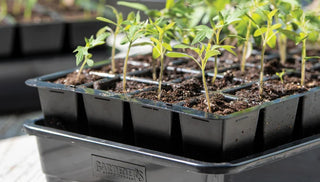For some kinds of plants, success in the garden requires a head start indoors. Though beans, carrots, corn, sunflowers and nasturtiums can (and should) be planted as seeds directly into the garden, the seeds of lots of other plants are usually sown in pots indoors and the young plants get set out into the garden several weeks later.

Our Self-Watering Seed Starters
GrowEase
Durable, Recycled Plastic Trays are Dishwasher-Safe
- Made from recycled plastic
- Dishwasher-safe tray and reservoir
- Cells are 2.25" deep
Deep-Root
Extra-Deep Cells for Bigger Root Systems and More Robust Plants
- Oversized cells accommodate larger root stystems — 50 percent deeper than similar seed starters
- Cover has adjustable vents
- Dishwasher-safe tray and reservoir
- 15 cells, each 3.5" deep
Why do gardeners plant certain seeds indoors and others directly into the garden? In some cases the plants require a long growing season and need extra time in order to reach their full potential. Onions, leeks, parsley and petunias are good examples. Sometimes a plant's seeds are so small that they get lost or overwhelmed if planted directly into the garden. To ensure the success of crops that are replanted during the growing season, such as lettuce and broccoli, it's often best to rely on transplants rather than sowing seeds right in the garden.
When starting seeds indoors, you'll want to use the right growing medium and be sure to give your plants adequate light. But what sort of container will you plant the seeds into? There are lots of different options, from yogurt cups and milk cartons to biodegradable pots, recycled plastic 6-paks, and seed-starting systems, such as the the GrowEase, the Deep-Root and the APS, all featured in the sidebar, at right. Here are some factors to consider:
Some seeds aren't fussy
Growing marigolds from seed is a popular grade school project and for good reason. The seeds germinate quickly and will grow in just about anything from a paper drinking cup to an old shoe. Other seeds can be more difficult. Parsley, peppers and the seeds of most perennial herbs and flowers require several weeks to germinate and many more weeks of growth before they can be transplanted into the garden. For plants that grow slowly, it's usually important to maintain consistent moisture and temperature. Some plants won't tolerate having their roots disturbed, so the entire root ball must be transferred into the garden intact.
Some seeds grow quickly and some grow slowly
Slow-growing seedlings such as onions, peppers, snapdragons and perennial herbs may be happy for many weeks growing in a small pot. Fast-growing seedlings, such as melons, tomatoes and zinnias, will outgrow a pot much more quickly.
Some seeds are small and some are big
Zinnia seeds are about a quarter-inch long, so it's easy to plant one zinnia seed to a pot. It's almost impossible to plant one snapdragon or nicotiana seed to a pot because the seeds are smaller than a grain of sand. For tiny seeds, the best option is often to sow a tiny pinch and plan on thinning (taking out the extras) later.
Keeping these considerations in mind, we recommend experimenting with several different kinds of pots and trays until you find the ones that work best for you and your plants. Matching seeds to growing systems gets easier with experience. Once you have grown out a particular plant from seed to bloom, you'll know how it grows and will be able to select the ideal type of container for healthy, happy seedlings.






